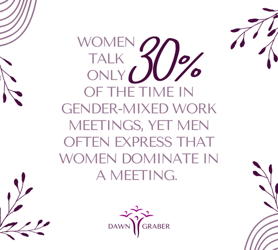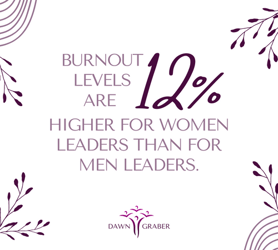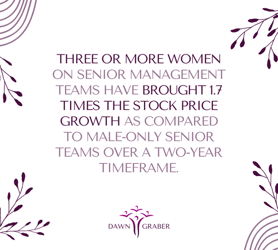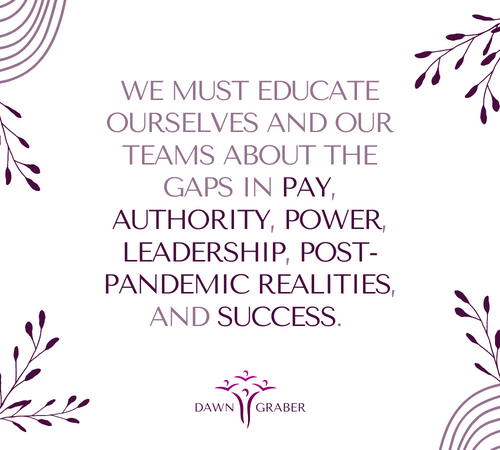It’s 2023. And yes, women’s work is... (Part 2)
It’s 2023. And yes, gender gaps remain real for working women in the US and worldwide. We, too easily, silence the facts and disallow the truth of persistent gender bias to sink in and propel both we and others toward resolving actions. The world needs the leadership gifts of many who identify as a woman. So we must inform ourselves and discern resultant action steps together because of the current leadership reality that equates ‘male’ as the leader in our culture. We must acknowledge and act on the gaps concerning women in leadership. Please read my February post to review the current gap for women in #1 pay, #2 authority, and #3 power. This month let’s look further at realities for women in leadership, specifically highlighting:
- Gender Leadership Identity Gap
- Gender Post-Pandemic Gap
- Gender Success-Gap
Gender Leadership Identity Gap
Women often struggle to be considered competent leaders due to the lens through which others equate males with leadership. This cultural reality needs to be disrupted because it is rarely known or believed without further examination. Here are some realities that surface for women leaders that need to be known so they can be acted upon to change:
- Women talk only 30% of the time in gender-mixed work meetings,
 yet men often express that women dominate in a meeting. How many times has a man insinuated you’re talking too long when you do share your thoughts? Are you really?
yet men often express that women dominate in a meeting. How many times has a man insinuated you’re talking too long when you do share your thoughts? Are you really? - Men interrupt women more and will interrupt with negative comments 70% of the time if a ratio of 4:1 men to women is present. If primarily women are present, men’s interruptions are negative 20% of the time. This is one reason why being an ‘only’ in a room of decision-makers is never a good idea.
- Women need to provide evidence of their competence twice as often as men do. Remember, men have the habit of positioning what they can do, and women are sized up based on what they have done. When advancing the corporate ladder, this biased lens difference is too often a negative mark against women being chosen for advancement.
- Women experience their judgment questioned more than men.
- Women are mistaken for someone junior 2x’s more than men leaders.
- Women leaders are 10% more likely to have their idea attributed to another male coworker instead of the same happening to a male leader.
- The gender, skin color, and role of being a mother affect women’s ability to get a raise/promotion.
- Women in executive leadership do 39% more of their family’s work in the home and/or childcare. The gap is 28% for entry-level jobs between women and men. Consider the great exodus of women in executive positions since the pandemic. We can respect that women are choosing wellness over the rat race, or we can realize in part this is because they literally are working themselves into a forced decision because of lack of support.
- Women with marginalized identities, such as LGBTQ+ or women with disabilities, experience a poorer work environment and are discounted as leaders more.
Action Plan: Appoint a gender bias educator and monitor to teach all staff how to notice and call out when discriminatory behavior & microaggressions are exhibited. Offer continuous feedback loops for psychological safety self-assessments with inclusion and belonging present for especially women and marginalized identities. Set up anti-bias reviews and promotional parameters for all gender identifications. Offer childcare assistance with flexible schedules and remote work options to help women leaders’ responsibilities outside work.
Resources to Reference:
- The Authority Gap by Mary Ann Sieghart
- Women in the Workplace
Gender Post-Pandemic Gap
Women suffered throughout the pandemic by working longer hours, taking the primary responsibility for elders and childcare, and receiving less workplace support as they worked remotely. So many women left the workplace that some data shows we have lost years of gender gain in employment. What have we learned from women in leadership now on this side of the pandemic?
- Women want opportunity, flexibility, employee well-being valued, and diversity, equity, and inclusion practiced. Women are switching jobs at the highest rate ever and more than men.
- Women who work remotely or in hybrid receive less support and advancement opportunities but experience fewer microaggressions, and for women with disabilities, less micromanagement.
- Burnout levels are 12% higher for women leaders than for men
 leaders.
leaders. - Women leaders care for employee wellness needs more actively than men leaders.
- Women leaders see through implementation 2x’s more than male leaders and participate in DEIB initiatives without acknowledgment as part of the job description; therefore, such attention is non-promotable.
- 49% of women leaders consider flexibility a top 3 need compared to 34% of men leaders.
- Younger women value an equitable, supportive, inclusive workplace.
Action Plan: Update your senior executive job descriptions, including an executive’s commitment to developing team well-being, as well as nurturing and participating in company-wide diversity, equity, inclusion, and belonging efforts. What can be measured can be rewarded with promotions. Develop the flexibility needed, especially for women and marginalized identities, to work off-site but commit to promotional visibility and team inclusion for their well-being and support. Expect managers to take mental health and wellness days for their heavy load. Reduce responsibilities as you add new initiatives. Prioritize relationships with your team members to learn their needs, so they don’t experience burnout. Sponsor them with coaching and celebrate their commitment and hard work. Women are doing this hard relationship-building work, which pays off in the employee workplace with healthier cultures and productivity.
Resources to Reference:
Gender Success Gap
I celebrate the transforming influence of effective leaders, be they any gender identification. I teach about and support especially women leaders because they bring gifts our organizations need, and they make our goals and missions come into play better than in male-only led organizations. Check out just a few facts:
- A meta-analysis of 99 studies found that women are ranked as effective leaders much higher than men.
- Good communication and transformational leadership determinants from the research of how women governmental leaders had significantly fewer Covid cases and deaths.
- Women-founded companies between 2011-2020 have paid back their investors ten months earlier than male start-up founders.
- Companies with the most women on senior management teams earn 48% higher income.
- Three or more women on senior management teams have
 brought 1.7 times the stock price growth compared to male-only senior teams over two years.
brought 1.7 times the stock price growth compared to male-only senior teams over two years. - A different study showed that women appointed to the CEO role saw stock prices rise 20% more than male-led CEO public companies in two years.
- Women directors and chief executives take less aggressive risks than male leaders to foster greater success.
- Ten years of data ending in 2015 from the venture capital firm First Round found that investments with female founders performed 63% better than investments from all-male founding teams. Another study from the Boston Consulting Group found over a five-year timeframe that looking at 350 women-owned start-ups made .73 for each dollar invested compared to .31 earning/dollar invested in male-only led start-ups.
- Women leaders exhibit 5 of the identified 9 leadership behaviors more than male leaders. These behaviors included people development, expectations and rewards, role model, inspiration, and participative decision-making. People development measured 7% stronger in women leaders than male leaders.
- Women are starting businesses 20% more than men committed to having a social or environmental impact. This purpose resonates with consumers today and benefits women business owners.
- Women in senior executive roles score significantly higher than men when three or more women make up the senior team in building a positive work culture, driving direction for the organization, offering coordination and control of all the moving parts, and managing the leadership team.
Action Plan: Steep your senior executive team and board in the facts. Create and implement a plan to diversify your offices where decisions happen, ensuring women are present. A diverse team of leaders, including senior executive women leaders, will position your organization for success. Women are not trying to lead alone. We need our male colleagues and their wisdom and unique skills. Together we can be golden for increased business outcomes and relational wellness with a culture that retains employees.
Resources to Reference:
- The Authority Gap by Mary Ann Sieghart
- Women in the Workplace
- When Women Lead: What They Achieve, Why They Succeed, and How We Can Learn from Them by Julia Boorstin
- Women Matter: Women Leaders, a competitive edge in and after the crisis by McKinsey & Company

There are real gaps for women leaders in the workplace today. We must educate ourselves and our teams about the gaps in pay, authority, power, leadership, post-pandemic realities, and success.
We do so and take steps to rectify these gaps because we want what’s best for ourselves in using our full gifts, we want what’s best for our senior team members, and we want the organizations we lead to flourish, which happens more as women are included in the senior leadership roles.
I'd love to support you in your leadership journey through the new Women in Leadership Rise Cohort starting at the end of April. Check it out for more information and let me know if you have any questions.
Transforming influence alongside you,

What I'm Reading:
- The Authority Gap: Why Women Are STILL Taken Less Seriously Than Men, And What We Can Do About It by Mary Ann Sieghart
- Better Work Together: How the power of community can transform your business by Susan Basterfield & Anthony Cabraal
- The Digital Pivot: Secrets of Online Marketing by Eric Schwartzman
- Leaf by Niggle by J.R.R. Tolkien


March 9, 2023
Comments